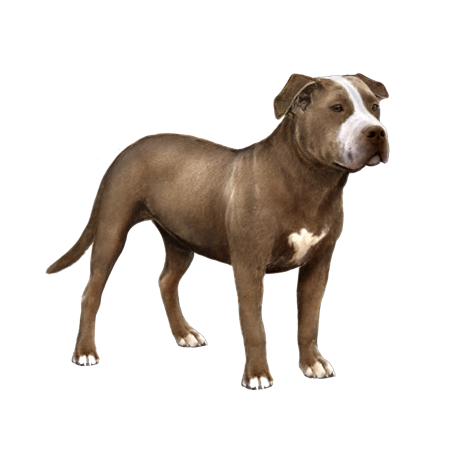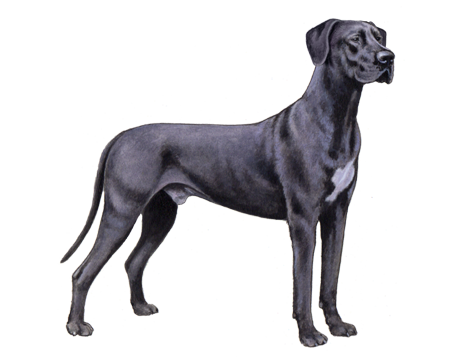
Bull Terrier
Brave, strong, and intelligent, Bull Terriers make excellent pets. They show their families gentleness, affection, and undying devotion.
Interested in discovering if your dog is a Bull Terrier?
Check out Wisdom Panel's DNA tests.
Bull Terrier Traits
General Appearance
Bull Terriers are strong, hearty, big-boned dogs with muscular bodies.
Coat and Coloring
This breed's short and stiff coat may be solid white or colored. Colors include brindle (black and brown stripes), black and tan, fawn, or red with varying amounts of white. Some dogs have pink skin around the muzzle and nose.
Distinctive Physical Traits
A long, oval-shaped head, upright and pointed ears, and small, triangular eyes are signature characteristics of the Bull Terrier.
Bull Terrier Temperament
Bull Terriers typically have playful personalities. They’re charming and can be mischievous—in an almost clownish or comical way. Though they can be headstrong at times, Bull Terriers make devoted, lifelong companions. They're very loyal to their people and usually good with children. (That said, all dogs need careful supervision when around kids.)
These pups may be unpredictable or unfriendly toward dogs or other pets. Interaction with strangers, however, shouldn’t be a problem. Bull Terriers are very sociable dogs, and they quickly accept others if introduced appropriately.
Bull Terriers can become destructive if left home alone for long periods. They may also develop food aggression in multi-pet households. But with proper supervision and training, they usually get along well with non-human family members. Because of their stubborn and independent nature, Bull Terriers require patient, reward-based training methods.
Bull Terrier History
In the 1830s, bullfighting enthusiasts wanted dogs with greater agility. To meet this demand, breeders began developing the Bull Terrier. They crossed Old English Bulldog with Old English Terrier and threw Spanish Pointer into the mix, too. But the resulting breed didn’t perform as well as bullfighting enthusiasts had hoped, and the Bull Terrier’s popularity as a bullfighter decreased.
Fortunately, their popularity as a pet increased. When breeders produced an all-white Bull Terrier in the 1850s, people immediately adored the breed. And over the years, people have tried adding Dalmatian, Greyhound, Foxhound, and Whippet into the Bull Terrier bloodline.
To meet the desire for a smaller Bull Terrier that could work as an above-ground ratter, breeders developed a miniature version of the breed. The American Kennel Club initially recognized the Bull Terrier as one breed with multiple sizes—standard and miniature. But in 1991, they recognized the Miniature Bull Terrier as its own breed.
Bull Terrier Care
Nutrition
Bull Terriers thrive on a high-quality diet that is age-appropriate—whether commercially produced or homemade (with approval and guidance from a veterinarian).
This breed is prone to obesity, so it’s important to monitor the amount of food you give them. If your pup gains excess weight, reduce their meal portions or cut back on treats.
Grooming
The Bull Terrier’s coat requires little maintenance to stay in tip-top shape. Weekly brushing with a soft-bristle brush, hound glove, or rubber grooming mitt/tool will help remove loose hair.
Regular nail trimming is a must for Bull Terriers. Overly long nails can cause pain, and may even contribute to walking and running problems.
Lastly, aim to establish a routine of at-home teeth brushing to support your dog's dental health between professional cleanings.
Exercise
Bull Terriers like to play and require moderate amounts of physical exercise and mental stimulation. Long walks around the neighborhood with the family or active games should do the trick. Standard-sized Bull Terriers make good jogging partners, too.
Because of their strength and athletic ability, Bull Terriers also tend to enjoy dog sports such as agility, flyball, rally, and competitive obedience.
Training
Both early socialization and gentle (but firm) training are essential for bringing out the Bull Terrier’s best qualities. This breed is inclined to guard, so focus on tempering this tendency to maintain a safe household.
Bull Terriers often prefer frivolous and fun activities over working dog jobs. A great way to start a training routine with your pup is to use positive reinforcement along with patience and humor.
Bull Terrier Genetic Health Conditions
-
Laryngeal Paralysis (Discovered in the Bull Terrier and Miniature Bull Terrier)
Laryngeal Paralysis is a condition that results from impaired nerve function supplied to tissues protecting the opening of the windpipe, leading to breathing difficulties and potential airway obstruction. The associated genetic variant is a risk factor that has been identified in the Bull Terrier and Miniature Bull Terrier.
-
Lethal Acrodermatitis (Discovered in the Bull Terrier)
Lethal acrodermatitis (LAD) is a disease characterized by poor growth, immune system deficiency, skin problems and infections.
-
Polycystic Kidney Disease
Polycystic Kidney Disease (PKD) is a condition causing formation of cysts in the kidneys which leads to chronic kidney failure.
-
Primary Lens Luxation
Primary Lens Luxation (PLL) is a condition that can cause the lens of the eye to become loose and eventually displace. The disorder is caused by degeneration of the fibers that hold the lens in place.
Knowing if your Bull Terrier is a carrier or at-risk for these conditions can help you and your veterinarian plan for your pup’s lifelong care. With Wisdom Panel™ Premium, you can get results for over 200 genetic health tests.
Breed Group
Guard
Dogs of the Guard Group were bred to guard people and property. They are often quick to learn and these intelligent, capable animals make solid companions.


































